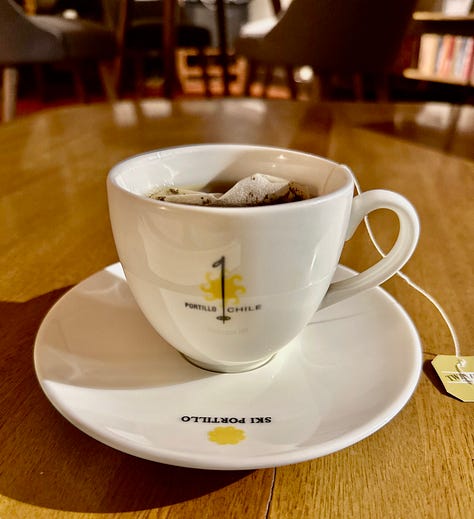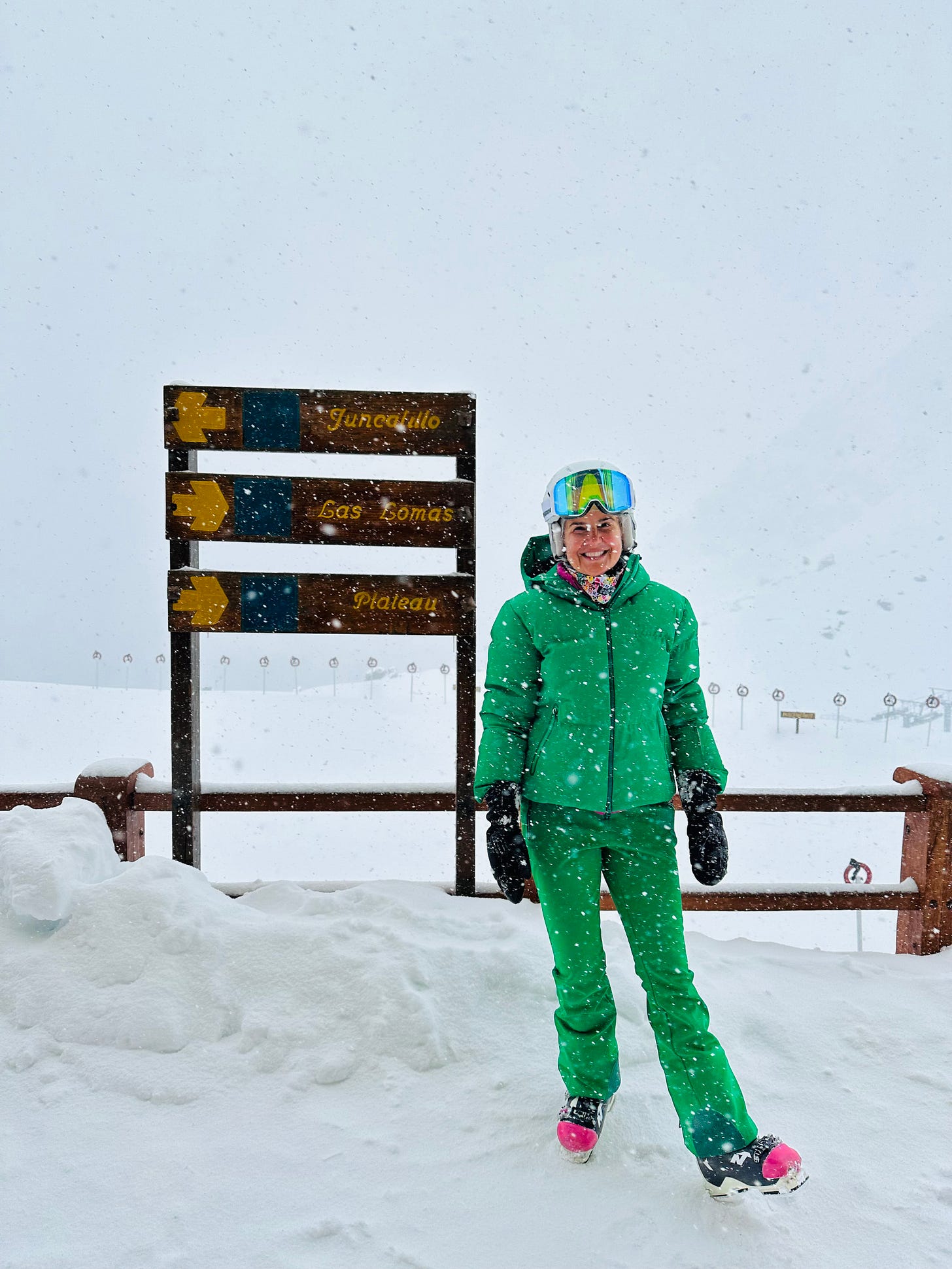Chasing Winter in Summer: A Ski Mom’s Guide to Portillo, Chile
What to Know Before Taking Your Family to This Iconic Chilean Ski Resort
I’ve been sitting with my Portillo experience for a week now. It was so vastly different from my other skiing adventures in the past few years, I’ve been wrestling with how to categorize it. I think I’ve finally figured it out: Portillo Ski Week feels like a vacation, not a trip.
Vacation vs. Trip
Most of us who plan ski getaways feel stretched thin. We wedge ski trips into packed family schedules. Once the dates are set, the logistics kick in: lodging (sight unseen), fingers crossed for good snow, and hopes for decent dinner reservations. We set reminders for ski school registration, pack all the gear, and cross our fingers that it all works out. When we arrive, we hold our breath, praying all the stars align for those magical winter memories.
But I’m here to tell you: there is a way to toss that stress out the window and create a trip that delivers for everyone in the family (especially the planners of ALL THE THINGS). It’s called Portillo Ski Week.
I’ve heard Portillo compared to a luxury cruise ship, but I don’t think that’s quite right. Cruises feel passive and transactional. Yes, there’s no shortage of food or entertainment, but you won’t see something like an Andes sunrise over a frozen lake. Portillo gives you adventure without the usual pain points.
Getting There
The biggest hurdle to Portillo is getting there. Santiago de Chile Airport has non-stop flights to 64 destinations in 18 countries. Check routes here.
We booked a direct flight from JFK to Santiago with LATAM (a Delta partner, so we earned miles). We splurged on first class—it’s a 9.5-hour trip and I’m recovering from a back injury. The flight was smooth, food fine (though my in-seat console didn’t work). Santiago’s airport was efficient and newly renovated.
From there, Portillo is 93 miles away. A week before arrival, we booked direct transport through the resort. A private shuttle for two was $510 (plus $40 tip each way—budget $600 total). A snowstorm turned the 2.5-hour drive into 4 hours. On the way back, traffic made it even longer. Pro tip: assume a 4-hour transfer, not 2-3.
As you near the Andes, the roads get tricky—narrow, rural, and confidence required. Then come the 27 numbered switchbacks. Trust your driver, don’t look down, and enjoy the ride. Ski Moms Tip: Don’t rent a car. You won’t need it.
Once you’ve safely made it to the hotel (and you will), you’ll see a large blocky building. There’s no hiding the ugly shape of the hotel, thankfully the bright swaths of yellow and blue paint make the dreary, soviet-style architecture look inviting and fun.


A Brief History of Hotel Portillo
Portillo is near the Argentina-Chile border. In 1910, it started as a train station connecting the countries. The train tracks were tough to maintain, but worked for decades. In 1949, the Chilean government opened a state-run hotel to capitalize on the snowpack. In 1961, the ski area was privatized with American businessman Robert W. Purcell as the lead investor.
The 1966 World Cup helped put Portillo on the map. Since then, the Purcell family has run it with care. Henry Purcell (Robert’s nephew), his wife Ellen Guidera, their sons, and a dedicated team now oversee operations. In its 76th season, Portillo remains a must-visit for global skiers.
The Hotel
The lobby is classic, with exposed beams and carved wood. It feels analog in the best way. Most guests are given a warm welcome by Felipe, the resident host extraordinaire, who will help you sort out your room and luggage.
The hotel has 123 rooms and two very busy elevators. We stayed in Room 521, a renovated, mountain-facing room with a stunning lake view. It had plenty of space to stow ski gear—just how I like it. Other options include family rooms, suites, and adjoining options. Booking agents can guide you.
Each floor has its own housekeeping staff, and our room was always fresh. That said, hotel hallways felt dated and lacked the lobby’s charm. Important note: the septic system is delicate. Toilet paper goes in the trash. Staff empties cans frequently.
Guests quickly learn the layout an figure out when to take the stairs and when to wait on the elevator. The restaurant and bar are on floor 2, lobby on 1, slopes and gym on 0. Rooms are on Floors 1-7. Trust me, you’ll master it, especially after Felipe’s tour.




The Rhythms of Portillo
I’ll cover lessons and on-snow details in a separate post (there’s too much to squeeze in here). But I want to share the cadence of a typical day.
There’s no mad dash. We’d wake early, stretch or hit a class at the gym, enjoy breakfast, then head to the slopes. Since Portillo limits skier volume, there’s no scramble for powder. The ski lounge gets busy, but it retains it’s clubby vibe.
Getting ready is easy, thanks to Javier, who runs the boot check. He never forgets a face. After Day 1, he had our boot numbers memorized and slippers ready before we even asked. Tip: Bring slippers or crocs—you’ll wear them to breakfast and switch to boots downstairs.
Once you are booted up, lessons are right out the back door. Or you can click in head right to the lifts. There will be no flop sweat of making a lesson at Portillo! We’d opted for the late lunch so we’d ski until lunch and then maybe go back out for a few more runs, or…maybe not. I never felt guilty about going in after lunch since we knew we’d be getting another great day the next day.
At 5 p.m., tea is served in the dining room—an après-ski ritual with baked goods and ham-and-cheese sandwiches. Most guests show up in base layers. It’s casual and comforting.
Families tended to wind down with reading or board games in the inviting hotel living room, or pool time. The three pools are different temps—we found our “just right” and soaked up those Andes views. Massages are $60/hour and absolutely worth it. We booked more than one—check in at the spa desk after 2pm to sign up.
In addition to the pool area and small spa suites, there’s a full gym. Like the hallways, this could use a refresh too, but the equipment was all in good shape and the warm-up and stretching classes were excellent. We really enjoyed the morning 8:30 “activation” with Martin. He’s a member of the Chilean Ski Team and we’ll look to cheer him on in cross country ski events at the next olympics.
Entertainment
For adults, the evenings were full and lively. Post-dinner options included:
Movies in Spanish or English
Live music at the bar (we saw jazz and 3 bands)
Reading in the library (if you want a low-key option).
The disco opens late and runs into the wee hours. We checked it out once—it wasn’t crowded, but we’re told August is peak party time.
Kid Stuff
Spoiler alert: I’ll dive in more later, but the kids’ lessons are something special here. But that’s just the tip of the Andes—kids are well cared for. There’s a wing just for them.
Basketball arena (NBA-sized!)
Climbing wall
Craft room
Ping pong, foosball, billiards
Entertainment desk with staff to organize activities
There’s also a daycare center that’s clean, bright, and free to use. Yes, free.




The Food
Meals are mostly included (except for the bar and on-mountain dining). Breakfast is served from 7-10 and you don’t have to have a designated time. For the other meals, you will choose the early or late seatings. For lunch the options are noon or 1:15 and for dinner the early slot is 8 and late 9:15pm. Once you select your family will stick with your slot all week. And I hope you have a sweet tooth! The in-house bakery dreams up wonderful options served at lunch, dinner and tea time.
Here’s what to expect:
Breakfast: simple and fast. Eggs, cereal, fruit salad, house rolls, ham and cheese. The house rolls are served with every meal and are made fresh on location each day. I found them hard to resist.
Lunch: more thoughtful. Fresh salads, soups, pasta, fish, chicken. Always a dessert. Service was quick, sometimes hard to flag for refills.
Dinner: more leisurely. Starters like ceviche or greens, then mains ranging from lamb chops to Chilean sea bass. Wine is poured at the table (loved the Chilean Sauvignon Blancs). We ordered a bottle and stretched it over a few nights—the staff will store it for you free of charge.



How Much?
Most guests book the traditional ski week: seven nights, lodging, all meals, skiing, and entertainment. (Alcohol, massages, and lessons are extra.)
Our extras totaled about $750—including wine, massages, and gift shop splurges. Rates vary:
Early season (late June–mid-July): lower
Peak season (late July–September): higher
Expect to pay $3,500–$6,000 per person, depending on room type and timing. Discounted rates are available for children under 18.
Yes, $6K per person is a lot. But if you compare that to Jackson Hole, Aspen, or Vail, you’re looking at similar costs—with far more stress.
Ready to Book?
What I learned: Americans make it so hard on ourselves. Watching Brazilian families enjoy their ski week—no yelling, no tension—made me rethink how we do this. I think we hit a travel flow state. Everything just worked.
If you want something novel, exciting, and yes, relaxing, fire up your Spanish lessons and book a Portillo trip. You’ll get adventure, cultural connection, and space to unplug. The chill I felt by Day 2 had nothing to do with the Pisco Sour—and everything to do with a tried-and-true formula that actually works.











Hey Kim,
Super helpful and fun piece about Portillo! My wife and I are going early August, never been and super excited. Only thing I'm not looking forward to...the road switchbacks...Aaaaghhh!